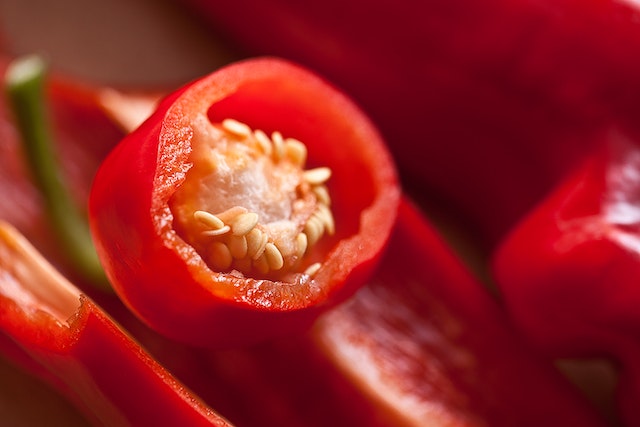Ever wondered why we feel a hot burning sensation when we eat chili peppers? Why does our tongue feel so hot, like a burn? At some point, all of us must have cried or had runny noses when we ate spicy foods. The culprit behind all these responses from our body is a chemical called Capsaicin present in the chilli peppers.
Capsaicin is a chemical substance naturally derived from chillies (Capsicum) that is known for its hot pungent taste. It is odourless, fat-soluble and it can be rapidly absorbed through the skin. It also has antifungal and antimicrobial actions. It has been used as food packaging, anti-fouling agents, and to prevent microbial and fungal growth in other plants. But it gives a burning sensation when it comes into contact with mammalian skins. Now comes the question, why does only Capsicum have this chemical, and why not other plants? Capsaicin is present in the white tissue that holds the seeds in fruits known as placental tissue and acts as a defense mechanism against herbivores like cows, and maybe also to prevent humans from eating it, but, ironically, the plant is being hunted for this defense mechanism which is supposed to keep us away from them.
This capsaicin was first isolated in 1846. Capsaicin receptors are called Transient Receptor Potential action channel (TRPV1) receptors. Birds do not have these receptors for capsaicin and they can eat chilli peppers without feeling the burns. And one fun thing about birds and chili peppers is that birds’ digestive system does not destroy the chilli peppers’ seeds and the seeds present in the faeces of birds can grow into a new plant!!! But this mechanism does not work in other animals. We can ask one question here- why not us, why not any other animal? Yes, it is indeed worth to a deep breath and appreciating how perfectly the balance in nature is maintained!!
Our body considers capsaicin as a chemical irritant, it stimulates our salivary flow as a defensive mechanism to dilute it and in turn, dilutes oral irritation caused by the capsaicin. People who are very sensitive to capsaicin tend to swallow spicy foods fast, without keeping them in the mouth for long. There have been many suggestions that prolonged exposure to tactile (touch and texture) stimuli causes it, or the irritation in the mouth caused by capsaicin makes us swallow the food quickly to defend the irritation in the mouth, or some even suggest both.
Experiencing a runny nose after eating something hot and spicy is quite normal for most of us. It was suggested that our body might have capsaicin receptors all over the body. This capsaicin can stimulate several reflexes in our body- maybe hypersecretion of mucous but there’s also another interesting fact that the response to capsaicin is quite different from histamine, a chemical that causes the common allergic responses in our body. Capsaicin is associated with intense burning pain, along with itching and sneezing. The weird and interesting thing is that capsaicin could activate both histamine and capsaicin-sensitive receptors while histamine receptors are hypothesized to respond only to histamine and the capsaicin-specific receptors are the ones that result in sensations of burning pain.
The pungency of capsaicin when we fry chilli causes irritation in our respiratory system when the gaseous particles of capsaicin float through the air and we inhale them. The capsaicin activates the receptors in our lungs making them more sensitive leading to massive coughing fits when our body tries to remove it from the respiratory system. When we are exposed to capsaicin, our tongue becomes extra sensitive to heat, and our brain interprets this as actual heat, which results in a potential adrenaline rush. Our blood vessels dilate, heart rate increases, and blood pressure increases preparing our body for the fight. Some people can show responses in the form of excess sweat and tears as a reaction to the heat as a cooling mechanism of our body. Talking about cooling, there have been reports that people in tropical areas use chili as a cooling mechanism when their body produces sweat and tries to cool down their body in response to the chili heat. Capsaicin burn shows similar responses similar to severe types of burns even similar to 3rd-degree burns.
Whenever we get capsaicin burn, we try to counter it by drinking lots of lots of water, but in reality, it doesn’t help at all, does it? As already mentioned earlier, it’s because capsaicin is a fat-soluble chemical and not soluble in water; how much water we drink won’t help us. Instead, we can try taking something that contains lipids- milk, ice cream, etc. This will help us wash away the capsaicin present in our mouth so that the receptors don’t come in contact with capsaicin and reduce the burning response. We can try drinking cold water to counter the heat in the tongue, but again which was mentioned earlier, won’t help with the removal of capsaicin.
References:
- .Xiang, Qunran, et al. “Capsaicin—the spicy ingredient of chilli peppers: A review of the gastrointestinal effects and mechanisms.” Trends in Food Science & Technology 116 (2021): 755-765.
- Panchal, S., Bliss, E. & Brown, L. Capsaicin in Metabolic Syndrome. Nutrients 10, 630 (2018).
- Hayman, Mark, and Peter CA Kam. “Capsaicin: a review of its pharmacology and clinical applications.” Current Anaesthesia & Critical Care 19.5-6 (2008): 338-343.
- Wang, F., Xue, Y., Fu, L., Wang, Y., He, M., Zhao, L., & Liao, X. (2021). Extraction, purification, bioactivity and pharmacological effects of capsaicin: a review. Critical Reviews in Food Science and Nutrition, 1–29.
- Hayman, M., & Kam, P. C. A. (2008). Capsaicin: A review of its pharmacology and clinical applications. Current Anaesthesia & Critical Care, 19(5-6), 338–343.
- Hawro, T., Lehmann, S., Deuring, E., Weller, K., Altrichter, S., Church, M. K., Metz, M. (2019). Comparison of pruritus and sensory qualities induced by capsaicin, histamine, and cowhage. Journal of the European Academy of Dermatology and Venereology.

